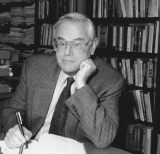|
||||||||||||||||||||||||||||||||||||||||

Stuart C. Schwartz
|
Stuart C. SchwartzProfessor of Electrical EngineeringPh.D. 1966, University of Michigan
My research interests are in the area of statistical signal processing as applied to problems in communication theory and image processing. I have worked in the areas of discrete-time estimator-correlators, adaptive and robust detection procedures, mobile telephony, and time-delay estimation. I was one of the first researchers to use Fourier series methods in probability density estimation and related problems and (with D. Martin) introduced robust statistical procedures to signal detection problems in the engineering literature. With a colleague at Bell Labs, we developed an important technique to evaluate log-normal variables. This has proved central for the performance evaluations and probability of outage calculations in mobile telephony under the realistic assumption of both fading and shadowing. I continue to work in the area of wireless communications. My current research interests include integrating spatial and temporal processing for mobile networks, including robust array processing; equalization architectures for multiuser receivers; application of statistical techniques such as quickest detection procedures to problems in image processing; application of time-frequency methods to the characterization and detection of transient and nonstationary signals. Mobile telephony or, more generally, wireless communications encounters a variety of difficult technical challenges for its operation. This is especially so in an urban environment, where buildup and terrain cause fading and shadowing, and many closely packed users (in both space and frequency) cause cochannel and multiple access interference. The problems become amplified as the migration of wireless communications to all-purpose networks evolves; handling heterogeneous traffic such as voice, data, and video will require more extensive and sophisticated signal processing, such as adaptive and equalization techniques, and additional integrated processing. Two major reasons are the following: the higher data rates required will induce more intersymbol interference (ISI), and the heterogeneous traffic requirement of various data rates will generate additional and different kinds of multiuser interferences. We are studying a variety of techniques to mitigate these problems. Feedforward and feedback architectures for equalization in a multiuser environment in CDMA networks are being investigated, with a focus on complexity-performance tradeoffs. We are also studying basic signal processing algorithms for the detection and characterization of transient and nonstationary signals. Motivated by the short time duration of transient signals, quickest detection procedures have been applied to these problems, and time-frequency representations have also been constructed. We are also studying variations of the Gabor representation and have developed a novel LMS approach. This procedure gives more accurate estimates of the Gabor coefficients than the usual biorthogonal approach. We have also incorporated the "best basis" and matching pursuit algorithms into time-frequency-based detectors using an adaptive-window-length local cosine and wavelet packet transforms. Significant performance gains have been demonstrated. Applying the quickest detection techniques to object recognition in large image (or patterns of interest in large data sets), we have developed a technique for quickly determining whether a portion of an image does not have an object of interest. Our technique takes about 6-10 seconds, compared to previous methods that require about 5-10 minutes to process the image. We also exploit information from one scale into the next scale. This is a continuing research project. I joined the department in 1966 as an assistant professor, was promoted to associate professor in 1970 and to professor in 1976. I was chair of the department from 1985-1994. During that period the department grew from thirteen to twenty-four members, instituted a computer engineering activity on both the undergraduate and graduate levels, and established an advanced technology center (ATC) in photonics and optoelectronic materials (POEM). The POEM/ATC has received substantial capital and operations funding from the New Jersey Commission on Science and Technology. I have held visiting academic appointments at The Technion, Haifa, Israel; Dartmouth College; University of California at Berkeley; and at ETH, Zurich, Switzerland. During the academic year 1972-73 I was a John S. Guggenheim fellow, and during the academic year 1980-81, I was a visiting member of the technical staff, Bell Telephone Laboratories, Crawford Hill, New Jersey. |
|||||||||||||||||||||||||||||||||||||||